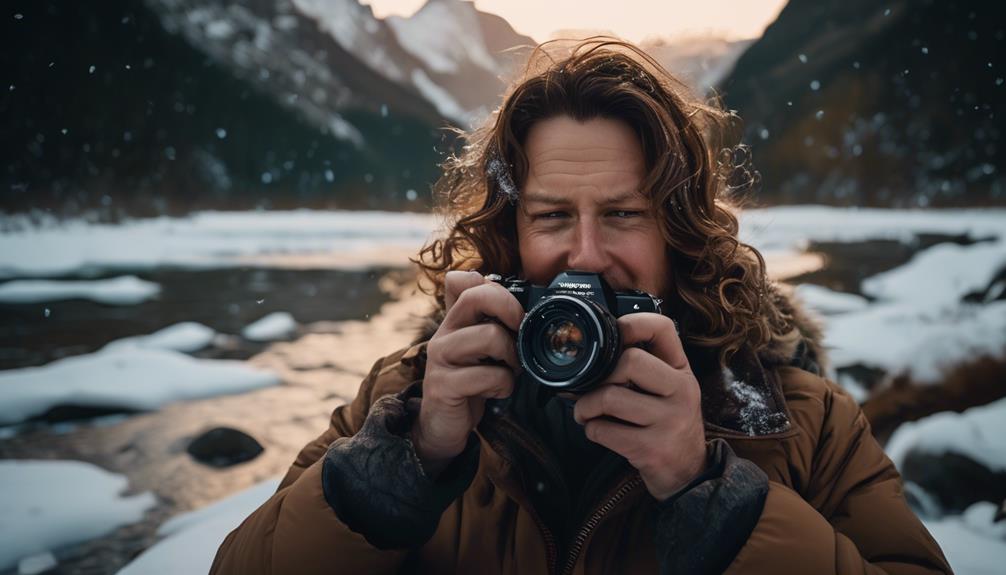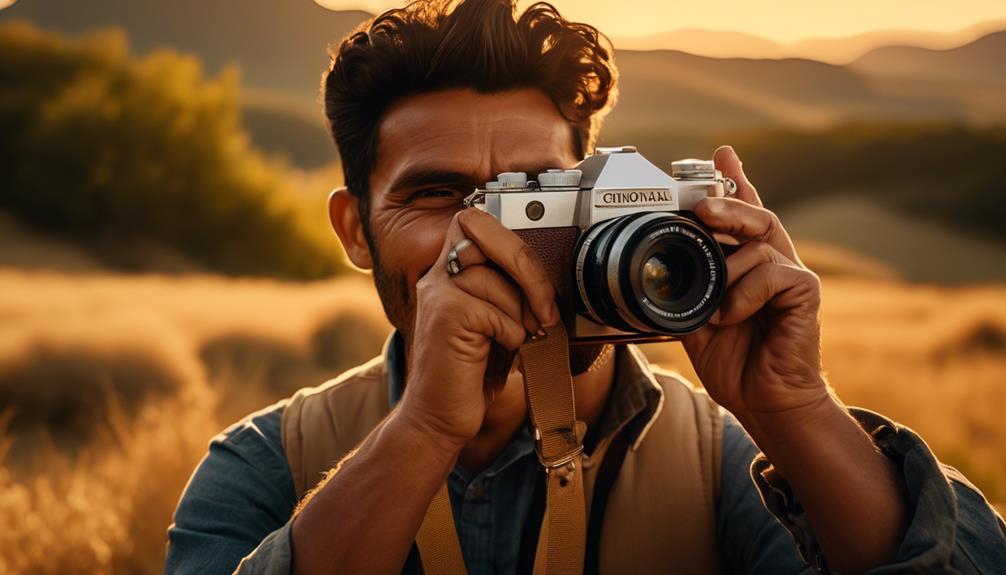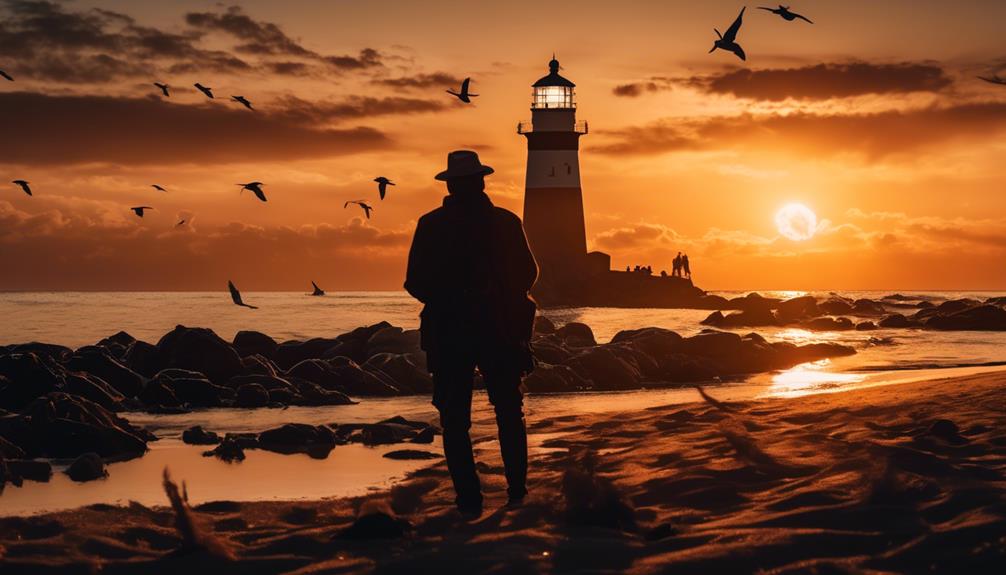Please note this post may contain affiliate links picked by me (Jay) that I have deemed may be of interest or relevant to you the reader of this.
These links do not affect the cost of the thing if you decide to purchase but i may get a little money if you choose to purchase.
For more information on my affiliate link policy click here.
Why settle for ordinary when you can elevate your photography to extraordinary heights? Let me tell you, my friend, there is a world of difference between a simple snapshot and a photograph that tells a captivating story.
We all know that a picture is worth a thousand words, but what if I told you that narrative imagery has the power to transport your audience to another time, another place, and another emotion? Intrigued?
Well, buckle up, because we're about to embark on a journey that will forever transform the way you view and capture the world through your lens.
Key Takeaways
- Storytelling is essential in photography as it unlocks the power and impact of the images.
- Visual narratives go beyond capturing beautiful images, as they convey emotions, tell stories, and engage the audience.
- Adding depth and emotion to photos can be achieved through unique perspectives, candid moments, and experimenting with angles and heights.
- Capturing authentic, unposed moments and utilizing composition, lighting, timing, and perspective contribute to compelling storytelling in photography.
Why Storytelling Matters in Photography
Storytelling is the key to unlocking the true power and impact of photography. As a photographer, I believe that narrative composition is of utmost importance in creating compelling and engaging images. When we think about the great photographs that have left a lasting impression on us, it's often the story behind the image that resonates the most.
The importance of narrative composition lies in its ability to guide the viewer's gaze and evoke emotions. By carefully considering the placement of subjects, the use of leading lines, and the incorporation of visual elements, we can create a visual story that captures the viewer's attention. A well-composed photograph with a clear narrative invites the viewer to delve deeper into the image, sparking curiosity and a desire to understand the story being told.
But why does storytelling matter in photography? It's simple – storytelling has a profound impact on viewer engagement. When we connect with a story, we become invested in the image. We start to question, interpret, and relate to the scene presented before us. By incorporating storytelling techniques into our photography, we can create images that not only captivate the viewer but also leave a lasting impression.
In today's fast-paced world, where attention spans are shorter than ever, it's crucial for photographers to embrace the power of storytelling. By telling stories through our images, we can cut through the noise and create a meaningful connection with our audience. So, the next time you pick up your camera, remember that the story you tell is just as important as the image you capture.
The Power of Visual Narratives
As a photographer, I have witnessed firsthand the transformative power of visual narratives in capturing the attention and emotions of viewers. Visual storytelling goes beyond just capturing a beautiful image; it is about conveying emotions, telling a story, and engaging the audience in a meaningful way. With the right composition, lighting, and subject matter, a photograph can transport the viewer into a different world and evoke a range of emotions.
To illustrate the power of visual narratives, let's take a look at the following table:
| Image | Emotion |
|---|---|
| A close-up of a child's face | Innocence |
| A stormy sky with dark clouds | Fear |
| A couple embracing under a sunset | Love |
| A lone tree in a barren landscape | Solitude |
| A crowded city street during rush hour | Chaos |
Each image in this table tells a story and conveys a specific emotion. By carefully selecting the elements within the frame, a photographer can create a visual narrative that resonates with the audience. Whether it's capturing the joy of a child's laughter or the intensity of a storm, visual storytelling has the power to elicit strong emotional responses.
Innovative photographers understand the importance of visual narratives in creating compelling and memorable images. They experiment with different techniques, perspectives, and compositions to convey emotions and engage their audience on a deeper level. By embracing the power of visual storytelling, photographers can elevate their work and leave a lasting impact on viewers. So, the next time you pick up your camera, think about the story you want to tell and the emotions you want to convey through your images.
Adding Depth and Emotion to Your Photos
To add depth and evoke emotion in your photos, consider incorporating unique perspectives and capturing candid moments. These techniques can create a connection between the viewer and the image, evoking reactions that make the photograph more impactful and memorable.
When it comes to perspective, try thinking outside the box. Instead of shooting from eye level, experiment with different angles and heights. Get down low to capture a subject from a worm's-eye view, or climb up high to shoot from a bird's-eye view. These unconventional perspectives can add depth and dimension to your photos, making them more visually interesting.
Additionally, candid moments have a way of capturing raw emotions that posed shots often lack. When people are unaware of the camera, their expressions and actions are genuine and authentic. These unguarded moments can evoke powerful reactions in viewers, as they feel like they're witnessing a genuine slice of life.
To capture candid moments, try blending into the background and becoming a silent observer. Avoid directing your subjects or asking them to smile for the camera. Instead, let the scene unfold naturally and be ready to capture those fleeting, heartfelt moments.
Capturing Moments That Tell a Story
One of the most powerful ways to elevate your photography is by capturing moments that have the ability to tell a captivating and compelling story. When you embrace candidness and capture those authentic, unposed moments, you create unforgettable memories that resonate with viewers and transport them into the scene.
To truly capture moments that tell a story, it's important to be observant and anticipate what might happen next. By immersing yourself in the environment and paying attention to the details, you can capture those decisive moments that convey emotion and narrative.
Let's take a look at a 3 column and 4 row table that illustrates how different elements can contribute to capturing moments that tell a story:
| Element | Example | Impact |
|---|---|---|
| Composition | Framing the subject off-center to create tension | Adds visual interest and draws the viewer's attention |
| Lighting | Utilizing dramatic lighting to enhance mood | Evokes emotions and adds depth to the narrative |
| Timing | Capturing the exact moment of action or reaction | Creates a sense of anticipation and tells a dynamic story |
| Perspective | Shooting from a low angle to showcase vulnerability | Provides a unique viewpoint and adds layers to the narrative |
Elevating Your Photography Through Storytelling Techniques
Storytelling is a powerful technique that can elevate your photography and captivate your audience. By incorporating storytelling techniques into your photography, you can enhance the composition of your images and create a deeper connection with your viewers.
Here are three ways to elevate your photography through storytelling techniques:
- Utilize leading lines and framing: Leading lines are a great way to guide the viewer's eye through your image, creating a visual narrative. Whether it's a winding road, a row of trees, or a flowing river, leading lines can add depth and dimension to your composition. Additionally, framing your subject within a natural or man-made frame can create a sense of storytelling by drawing attention to the main subject and adding context to the image.
- Capture moments of emotion: Emotion is a powerful storytelling tool. Look for moments of genuine emotion in your subjects, whether it's joy, sadness, excitement, or contemplation. These moments can create a connection between the viewer and the image, evoking a sense of empathy and allowing them to become emotionally invested in the story you're telling.
- Tell a story through juxtaposition: Juxtaposition involves placing two contrasting elements together in the frame to create a thought-provoking narrative. This technique can be used to highlight social or cultural issues, create visual irony, or simply add an element of surprise to your images. By juxtaposing different elements, you can create a story that sparks curiosity and engages your audience in a deeper level of interpretation.
Frequently Asked Questions
What Are Some Common Storytelling Techniques Used in Photography?
When it comes to storytelling in photography, there are several techniques that can be used.
Symbolic elements play a crucial role in conveying deeper meanings and emotions in an image. By incorporating objects or gestures with symbolic significance, we can add layers of narrative to our photographs.
Composition techniques also play a vital role in storytelling. Elements like framing, leading lines, and rule of thirds can guide the viewer's eye and help create a more visually compelling narrative.
How Can Narrative Imagery Help to Evoke Emotions in Viewers?
Eliciting emotional responses and enhancing viewer engagement are two key benefits of using narrative imagery in photography.
By creating a visual story, we can tap into the viewer's emotions and make them feel a connection to the image.
Through the use of composition, lighting, and subject matter, we can evoke joy, sadness, excitement, or any other emotion we want the viewer to experience.
This level of storytelling elevates our photography and allows us to create images that truly resonate with our audience.
Are There Any Specific Genres of Photography That Storytelling Techniques Work Best With?
When it comes to storytelling through photography, there are certain genres that lend themselves particularly well to this technique. Landscape photography, for example, allows for the creation of narratives through the use of light and composition.
Street photography is another genre where storytelling techniques can be effectively employed, capturing the essence of a moment or a place.
Can You Provide Examples of Famous Photographers Who Are Known for Their Narrative Imagery?
Gregory Crewdson and Cindy Sherman are two famous photographers known for their narrative imagery. They skillfully incorporate storytelling techniques in their work, such as juxtaposition and visual cues.
Their photographs tell captivating stories, evoking emotions and sparking the viewer's imagination. Symbolism plays a significant role in their narrative imagery, adding depth and meaning to their photographs.
Additionally, the use of lighting is crucial in their storytelling, creating atmosphere and enhancing the narrative elements. These photographers truly elevate photography with their innovative and compelling narratives.
How Can Photographers Effectively Convey a Story Through a Single Image?
When it comes to conveying a story through a single image, the key lies in incorporating symbolic elements and composition techniques.
By carefully selecting objects or elements that represent a deeper meaning, and using composition techniques like leading lines or rule of thirds, photographers can effectively communicate a narrative.
It's all about capturing the viewer's attention and sparking their curiosity.
It's fascinating how a single image can tell a whole story and leave a lasting impact on the viewer.
Conclusion
As photographers, we have the incredible opportunity to capture moments that tell stories. By incorporating narrative imagery into our work, we can elevate our photography to new heights. It adds depth and emotion to our photos, making them more engaging and powerful.
So next time you pick up your camera, think about the story you want to tell. Who knows what incredible narratives you'll create and what mysteries you'll unravel through the lens? The possibilities are endless, and the journey is just beginning.


